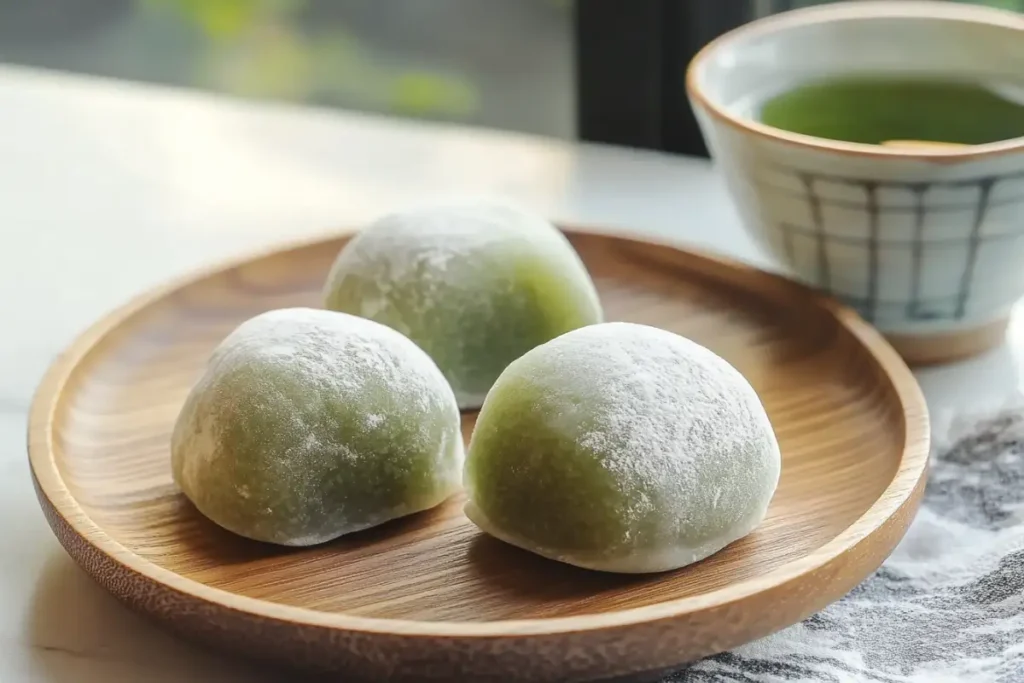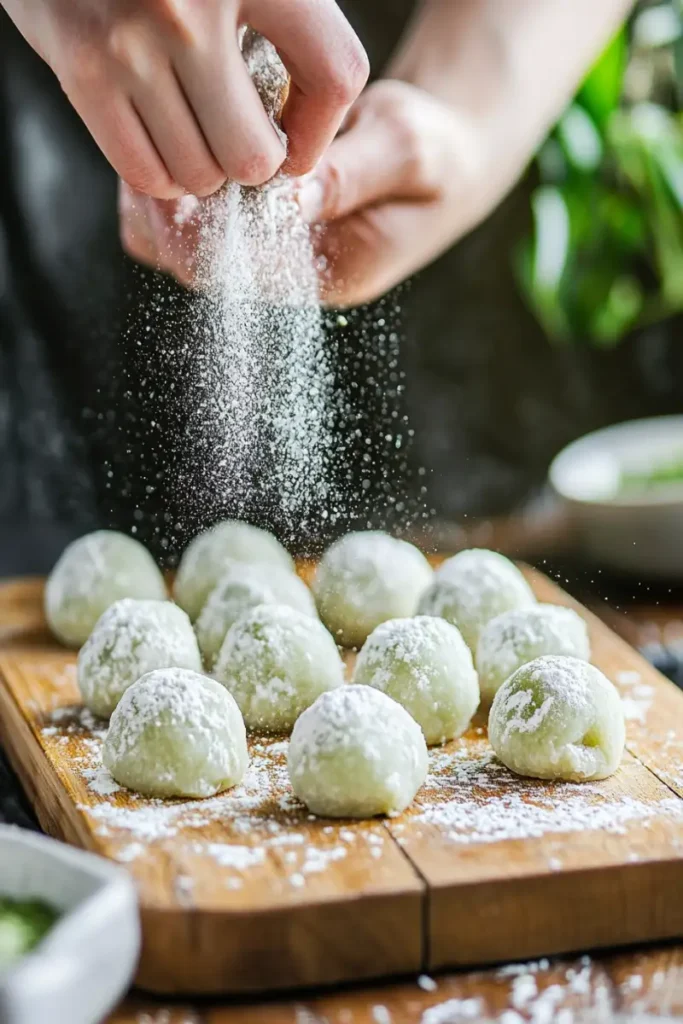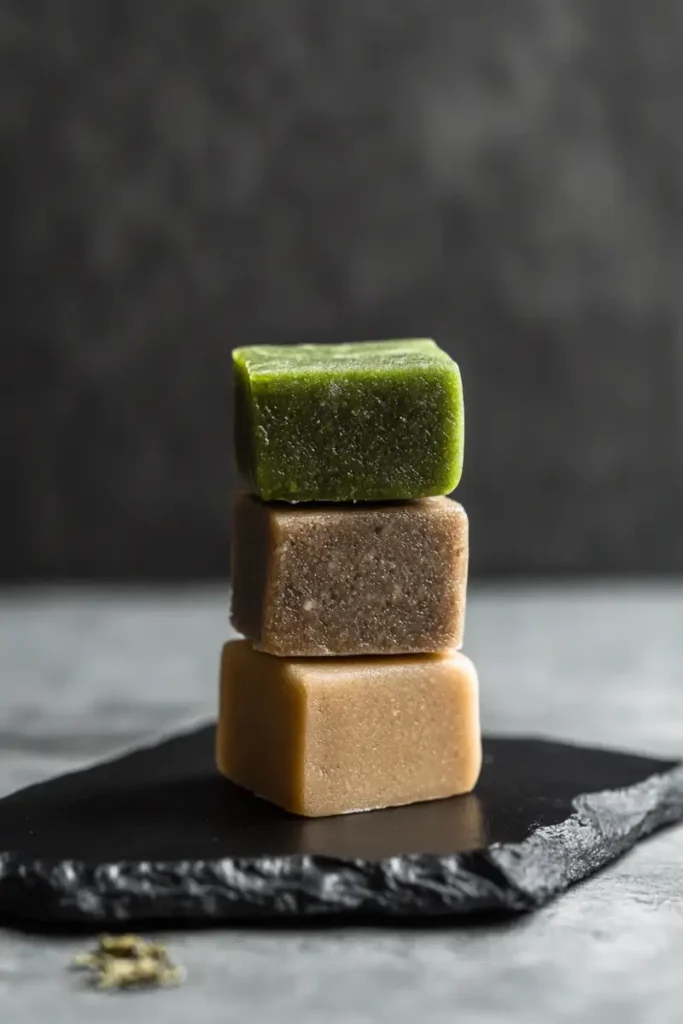
The first time I ever tasted tea mochi, it wasn’t in a trendy dessert bar or a carefully curated Instagram box of Japanese sweets. It was in my aunt’s quiet kitchen during a summer trip to San Francisco. She had just come back from a trip to Kyoto, and in her carry-on, nestled carefully between green tea tins and dried persimmons, were little round balls of chewy goodness earthy, grassy, lightly sweetened mochi infused with matcha. I didn’t know it at the time, but that moment would stay with me like the steam that clings to a cup of hot tea on a chilly afternoon.
Back then, I didn’t even know what mochi was, let alone that tea could be something you’d eat. But the soft bounce of the dough, the subtle depth of green tea, were like a story unfolding in my mouth. And now, years later, every time I make tea mochi in my own kitchen, I think back to that afternoon sun spilling through the foggy window, kettle whistling softly, and my aunt laughing as she dusted matcha off her apron.
I’ve made tea mochi countless times since then. Sometimes with matcha, other times with hojicha or jasmine. Occasionally, I get playful and stuff it with a boba-style milk tea filling. But no matter the variation, it always starts the same way: with glutinous rice flour, a memory, and a craving for something comforting and a little unexpected.
What Is Tea Mochi, Really?
Tea mochi is exactly what it sounds like: soft, chewy mochi flavored with tea. Usually green tea (matcha), though it can also be infused with roasted hojicha, black tea, Thai tea, or even jasmine. The chewy texture comes from glutinous rice flour (also called sweet rice flour), and the gentle tea flavor adds a calming, earthy element to what’s already one of the world’s most beloved snacks.
It’s not just a dessert. It’s a ritual. A tiny, pillowy bite of peace.
Why I Started Making Tea Mochi at Home
You know the one, where you try to recreate everything you tasted. I burned miso soup, bought three types of soy sauce, and spent a questionable amount of time sourcing kinako. But it was mochi that stuck.
At first, I was intimidated. The idea of pounding rice seemed impractical. But when I learned that you could make mochi using mochiko flour and a microwave? That was a game changer. I started with matcha, moved to hojicha, and then started experimenting with jasmine tea and even milk tea blends with tapioca pearls folded inside.
There’s something almost meditative about mixing the flour, folding in the tea, and dusting each piece with potato starch. It’s like origami for your tastebuds.
My Favorite Types of Tea Mochi
1. Matcha Tea Mochi: Classic and earthy. It’s the standard-bearer, with just enough bitterness to balance the sweetness of the mochi. I like mine filled with white bean paste or whipped cream.
2. Hojicha Mochi: This one is warm and toasty, perfect for cooler evenings. The roasted tea gives the mochi a subtle caramel-like flavor that pairs beautifully with chestnut or sesame fillings.
3. Jasmine Tea Mochi: Floral and delicate. I steep the jasmine leaves in warm milk before adding it to the flour, and the result is pure elegance.
4. Milk Tea Boba Mochi: For the bubble tea lovers, yes, this exists. Brown sugar boba folded into chewy mochi dough infused with black tea or earl grey.
And here’s the best part: you can customize everything. From sweetness to filling, it’s yours to shape.
Ingredients for Tea Mochi (Matcha Version)

Here’s what I use when making a simple matcha tea mochi with white bean filling:
- 1 cup mochiko flour (glutinous rice flour)
- 3/4 cup water
- 1/4 cup sugar
- 1 tsp matcha powder (culinary grade)
- 1/2 cup sweet white bean paste (shiro-an) or red bean paste (anko)
- Cornstarch or potato starch for dusting
Step-by-Step Instructions
1. Mix the Dry Ingredients:
In a microwave-safe bowl, combine the mochiko, sugar, and matcha powder. Stir well.
2. Add Water:
Slowly pour in the water while whisking until smooth and lump-free.
3. Microwave:
Cover the bowl loosely with plastic wrap and microwave on high for 1 minute. Stir. Microwave again for another minute. Stir again. Finish with 30 seconds if needed. The dough should be thick, sticky, and translucent.
4. Cool & Dust:
Let the mochi cool slightly. Meanwhile, dust your work surface with potato starch.
5. Shape the Mochi:
Scoop small portions of mochi onto the surface, flatten them into discs, place a teaspoon of filling in the center, then pinch and seal the edges.
6. Rest & Enjoy:
Let them rest for 10–15 minutes. Serve with hot green tea.
Where to Buy Ingredients (in the U.S.)
Most ingredients can be found at Asian supermarkets like H Mart, 99 Ranch, or Mitsuwa. Online, Amazon and Weee! are great sources. Here’s a breakdown:
| Ingredient | Where to Buy |
|---|---|
| Mochiko Flour | Amazon, Asian groceries |
| Matcha Powder | Matcha.com, Ippodo, or Trader Joe’s |
| White Bean Paste | H Mart, or make at home |
| Potato Starch | 99 Ranch, H Mart |
Tools Needed for This Recipe
- Microwave-safe mixing bowl
- Silicone spatula
- Fine mesh strainer (for matcha)
- Measuring cups/spoons
- Plastic wrap
- Potato starch for handling
What Tea Goes with Mochi?

It depends on the flavor of your mochi! For matcha mochi, I love pairing it with genmaicha—a green tea blended with toasted brown rice. It brings out the nuttiness and balances the sweetness.
If I’m serving hojicha mochi, I go with oolong. For jasmine mochi, a plain green or white tea works best. You can even try cold-brewed teas with ice in the summer. There’s no wrong answer—only combinations you haven’t discovered yet.
FAQ about the Tea Mochi
What is tea mochi?
Tea mochi is a sweet Japanese rice cake made with glutinous rice flour and infused with flavors of tea such as matcha, hojicha, or jasmine. It has a chewy texture and is often filled with sweet paste like red bean or white bean.
Is boba tea mochi halal?
Yes, most boba tea mochis are halal as long as the ingredients don’t contain alcohol, non-halal gelatin, or emulsifiers derived from animal sources. Always check the ingredient label or confirm with the manufacturer.
What tea goes with mochi?
Mochi pairs well with Japanese teas like sencha, matcha, hojicha, or genmaicha. The right tea depends on the flavor of the mochi. Floral teas like jasmine also pair well with milder mochi flavors.
Is mochi Japanese or Korean?
Mochi is traditionally Japanese, while tteok is the Korean counterpart. Both use glutinous rice but differ in preparation, texture, and cultural context.
If You’re Curious…
I’ve written about the Gelato Pistachio Recipe.
If you’re exploring other world sweets, check the Dessert category on the site.
Want something luxurious and savory? You might enjoy my Dubai Chocolate Recipe.
There’s also a guide on the site for how to make Mary O’s Irish Soda Bread Scones, too.
Final Thoughts
Tea mochi isn’t just a dessert; it’s a pause. A soft, sweet moment between sips of tea and the rush of daily life. Making it at home doesn’t require special tools or techniques, just a little patience, a warm kitchen, and the willingness to get your hands sticky.
If you try it, let me know. I’d love to hear which tea you chose, how you filled it, and if it transported you the way it did me, back to a station in Kyoto, the hiss of an arriving train, and the whisper of matcha in a chewy little bite.
Want to save this Tea Mochi recipe for later or share it with friends?
📌 Pin it on Pinterest
👍 Follow us on Facebook for more recipes!
Table of Contents
Perfect Tea Mochi
Soft, chewy green tea mochi with a hint of sweetness, it’s a classic Japanese treat. Learn to make these matcha mochi—they are a game changer!
- Total Time: 13 minutes
- Yield: 6 to 8 small mochi 1x
Ingredients
1 cup mochiko flour (glutinous rice flour)
3/4 cup water
1/4 cup sugar
1 tsp matcha powder (culinary grade)
1/2 cup sweet white bean paste (shiro-an) or red bean paste (anko)
Cornstarch or potato starch for dusting
Instructions
1. Mix the Dry Ingredients:
In a microwave-safe bowl, combine the mochiko, sugar, and matcha powder. Stir well.
2. Add Water:
Slowly pour in the water while whisking until smooth and lump-free.
3. Microwave:
Cover the bowl loosely with plastic wrap and microwave on high for 1 minute. Stir. Microwave again for another minute. Stir again. Finish with 30 seconds if needed. The dough should be thick, sticky, and translucent.
4. Cool & Dust:
Let the mochi cool slightly. Meanwhile, dust your work surface with potato starch.
5. Shape the Mochi:
Scoop small portions of mochi onto the surface, flatten them into discs, place a teaspoon of filling in the center, then pinch and seal the edges.
6. Rest & Enjoy:
Let them rest for 10–15 minutes. Serve with hot green tea.
- Prep Time: 10 minutes
- Cook Time: 3 minutes
- Category: Asian Sweets
- Method: Microwave
- Cuisine: Japanese
Nutrition
- Serving Size: 1 mochi (approx. 40g)
- Calories: 110 kcal
- Sugar: 10g
- Sodium: 5mg
- Fat: 1g
- Saturated Fat: 0g
- Unsaturated Fat: 1g
- Trans Fat: 0g
- Carbohydrates: 24g
- Fiber: 0.5g
- Protein: 1g
- Cholesterol: 0mg
Keywords: tea mochi, matcha mochi, homemade mochi recipe, mochi with tea, how to make mochi, Japanese rice cake, glutinous rice dessert, chewy mochi, green tea mochi, how to make tea mochi at home, tea mochi with matcha filling, easy microwave mochi recipe, best tea to pair with mochi, Japanese sweets with tea, is mochi halal, boba tea mochi ingredients, mochi recipe without gelatin
